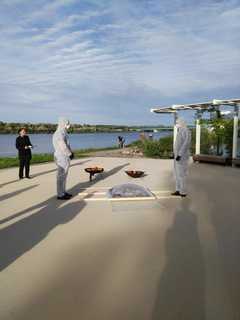


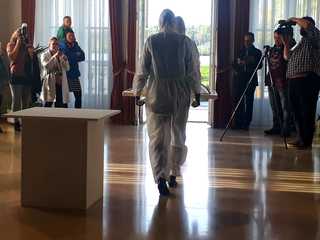
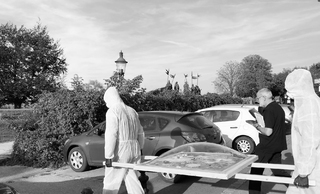
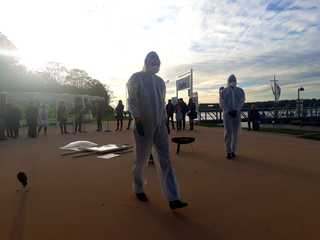
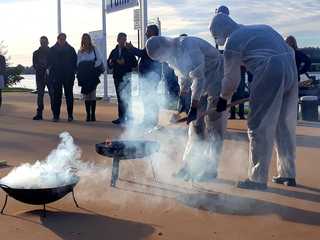
ritual 2018
abschied der tullner mikroben
A living work of art grows, changes, arouses curiosity, demands care, adapts and passes away. It is temporal, it draws attention to the moment, striving for meaning instead of possession.
The artwork 'multi-being' by Sonja BĂ€umel and Manuel Selg, which has been growing at the exhibition #TullnART Garten der KĂŒnstler since the beginning of May, will be closed in a ritual.
A group of people has gathered today for a ceremony of common experience, to give meaning and to celebrate care. Goodbye to the artwork 'multi-being', microbial Tulln bodies and their nutrients.
A growing, two-dimensional microbial surface, lying like a membrane over an abstract, three-dimensional and trans-border landscape. Bodies expand, liquefy, overgrow, get under the skin and unite. They become landscapes, biotopes and nutrient supply.The once liquid material fuses them together, allowing interspaces and exchange, while bringing bodies into direct contact.
The human body is a tiny particle in a living, pulsating, ever-expanding entanglement of multi-being.
A nutrient soil made of agar served as a meeting place for microbes from different environments. What happens when the microbial culture living on the surface of a keyboard of Tullnâs Mayor Mr. Eisenschenk sends signals to another microbial culture, for example the one living on a stone? And what happens if the microbes on Mrs. Rinderhofer's human skin start an exchange with those living on a cockchafer? With every touch, we pick up new microbes and leave others behind. Being an individual in the world also implies being a community of multiple beings in a living process of constant exchange.
Donna Haraway emphasizes the ethical aspect that living together also entails risk. It's not a romantic or sentimental idea to be together, it's about taking risks, to find the courage to open up to the different, which is not the same as we are. Allowing uncertainty, confusion and ignorance as the basis of our actions in the world. The effort is to make ourselves vulnerable in our explorations of our material relationships, with what is inherently foreign to us, yet so close.(1)
The microbial body landscape and its unreal magnitude invite us to broaden our ethical view, they want to question the boundaries, the relationships and the co-existence between different bodies. Why is life on a smaller scale and in a different body form worth less? How can a work of art enable a radically new view of biological rules, hierarchies, dimensions and scales?
(1) Translated from the quote in English, Fifty Percent Human, Exhibition brochure, Living in the big mesh by Alice Smits, Page 42, Oct, 2016
The artwork 'multi-being' by Sonja BĂ€umel and Manuel Selg, which has been growing at the exhibition #TullnART Garten der KĂŒnstler since the beginning of May, will be closed in a ritual.
A group of people has gathered today for a ceremony of common experience, to give meaning and to celebrate care. Goodbye to the artwork 'multi-being', microbial Tulln bodies and their nutrients.
A growing, two-dimensional microbial surface, lying like a membrane over an abstract, three-dimensional and trans-border landscape. Bodies expand, liquefy, overgrow, get under the skin and unite. They become landscapes, biotopes and nutrient supply.The once liquid material fuses them together, allowing interspaces and exchange, while bringing bodies into direct contact.
The human body is a tiny particle in a living, pulsating, ever-expanding entanglement of multi-being.
A nutrient soil made of agar served as a meeting place for microbes from different environments. What happens when the microbial culture living on the surface of a keyboard of Tullnâs Mayor Mr. Eisenschenk sends signals to another microbial culture, for example the one living on a stone? And what happens if the microbes on Mrs. Rinderhofer's human skin start an exchange with those living on a cockchafer? With every touch, we pick up new microbes and leave others behind. Being an individual in the world also implies being a community of multiple beings in a living process of constant exchange.
Donna Haraway emphasizes the ethical aspect that living together also entails risk. It's not a romantic or sentimental idea to be together, it's about taking risks, to find the courage to open up to the different, which is not the same as we are. Allowing uncertainty, confusion and ignorance as the basis of our actions in the world. The effort is to make ourselves vulnerable in our explorations of our material relationships, with what is inherently foreign to us, yet so close.(1)
The microbial body landscape and its unreal magnitude invite us to broaden our ethical view, they want to question the boundaries, the relationships and the co-existence between different bodies. Why is life on a smaller scale and in a different body form worth less? How can a work of art enable a radically new view of biological rules, hierarchies, dimensions and scales?
(1) Translated from the quote in English, Fifty Percent Human, Exhibition brochure, Living in the big mesh by Alice Smits, Page 42, Oct, 2016
- collaboration
- Ceremonial farewell:
Sonja BĂ€umel
Manuel Selg
Farewell Speech:
Rainer Friedl
Music:
Sax Arte Saxophone Quartet
Alexandra Pichler
Bianca Repas
Viola Jank
Markus Holzer - photographer
- Wolfgang Giegler (image 4)
Claudia Zatloukal (image 3,5,6)
Video documentation: Camillo Meinhart - support
- Wolfgang Giegler
Bgm Peter Eisenschenk
Culture-GR Peter Höckner
Karin Rinderhofer
Florian Pauser
GĂŒnter Klein
Gratitude goes to the support of
Sonja Schachinger
Rainer Friedl
Katja Himmelbauer